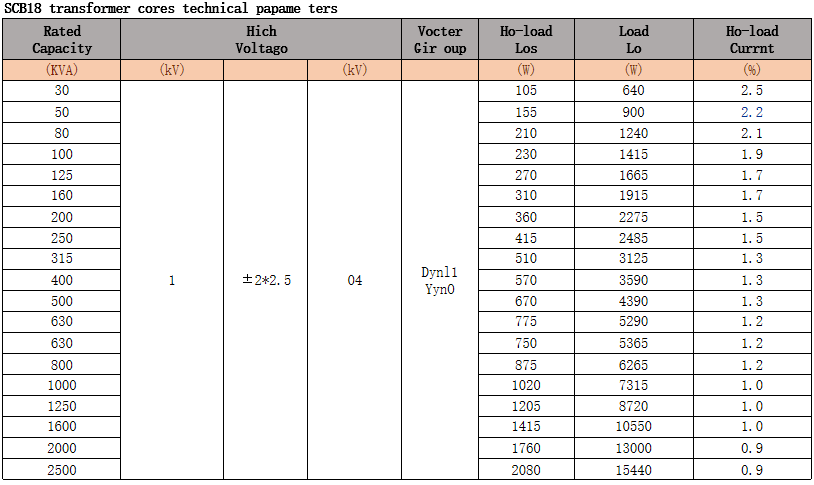-
Mobile Version
Scan with Mobile
- Member Center
SCB18 transformer cores
Iron Core Material
The iron core of the Scb18 transformer is usually made of high-quality cold-rolled grain-oriented silicon steel sheets. These silicon steel sheets have undergone advanced cold-rolling processes, so that the internal grains are arranged in a highly ordered manner along the rolling direction, which endows the iron core with excellent magnetic properties.
Performance Characteristics
• High Permeability
• The iron core has a relatively high permeability. This means that a relatively strong magnetic induction intensity can be generated under a relatively weak magnetic field strength. During the operation of the transformer, only a small exciting current is needed to establish a sufficient magnetic field, which helps to significantly reduce the no-load loss and thus effectively improve the operation efficiency of the transformer.
• Low Iron Loss
• Iron loss mainly includes hysteresis loss and eddy current loss. The cold-rolled grain-oriented silicon steel sheets used in the Scb18 transformer iron core have a narrow hysteresis loop and a low hysteresis loss. Moreover, the thin sheet structure and good surface insulation performance of the silicon steel sheets can effectively suppress eddy currents, keeping the eddy current loss at a low level as well. The combined effect of these two factors keeps the iron loss of the iron core at a low level and reduces the energy loss during the operation of the transformer.
• Good Magnetic Stability
• Whether under different working temperature conditions or when the load changes, the Scb18 transformer iron core can maintain relatively stable magnetic properties. This is crucial for ensuring the stability of the output voltage and current of the transformer, effectively reducing voltage fluctuations and waveform distortions, and providing stable and reliable electrical energy for the power system.
Iron Core Structure
• Laminated Structure
• A laminated iron core structure is generally adopted. That is, silicon steel sheets are stacked together one by one, and an insulating layer is set between every two silicon steel sheets. This structure can significantly reduce the flow path of eddy currents and thus effectively reduce the eddy current loss. Besides, the laminated structure is convenient for manufacturing and installation, and the size and shape of the iron core can be flexibly adjusted according to the specific specifications and requirements of the 
transformer.
• Three-Phase Iron Core Structure (for Three-Phase Transformers)
• In a three-phase transformer, the iron core mainly consists of three limb cores and upper and lower yokes. The three-phase windings are respectively sleeved on these three limb cores. This structure can make the distribution of the three-phase magnetic fields more uniform, reduce the losses caused by the imbalance of the three-phase magnetic circuits, and ensure the balanced operation of the three phases of the transformer.
Manufacturing Process
• Silicon Steel Sheet Processing
• First of all, the silicon steel sheets need to be processed. The coiled silicon steel sheets are cut into appropriate sizes and shapes according to the design requirements. During the cutting process, high precision should be ensured to ensure the tightness and accuracy of the subsequent laminations. In some cases, punching operations also need to be carried out on the silicon steel sheets to make holes for installing windings and other components.
• Insulation Treatment
• In order to prevent short circuits between silicon steel sheets and an increase in eddy current losses, the surface of the silicon steel sheets needs to be insulated. Usually, an insulating paint is coated on the surface of the silicon steel sheets or other insulating materials are used to ensure good insulation performance between adjacent silicon steel sheets.
• Iron Core Lamination
• The silicon steel sheets after insulation treatment should be laminated in a specified order and direction. During the lamination process, it is necessary to ensure the flatness and tightness of the laminations to avoid uneven or loose laminations, otherwise, it will have an adverse impact on the magnetic and mechanical properties of the iron core.
• Clamping and Fixing
• After the iron core is laminated, it needs to be clamped and fixed by means of clamps or binding to ensure the stability of the iron core structure. This can prevent the iron core from being displaced or deformed due to electromagnetic forces and other factors during the operation of the transformer.

Tel:+86 13931106889 / +86 19717485888
WhatsApp:+86 13931106889 / +86 19717485888
Facebook:+86 19717485888
Wechat:+86 13931106889
Email:13931106889@hbxinbian.com
Address:Chang'an Town North Zhougua Village, Gaocheng District, Shijiazhuang City, Hebei Province


